Yi Wen
Jack
A Survey of Personalization: From RAG to Agent
Apr 14, 2025Abstract:Personalization has become an essential capability in modern AI systems, enabling customized interactions that align with individual user preferences, contexts, and goals. Recent research has increasingly concentrated on Retrieval-Augmented Generation (RAG) frameworks and their evolution into more advanced agent-based architectures within personalized settings to enhance user satisfaction. Building on this foundation, this survey systematically examines personalization across the three core stages of RAG: pre-retrieval, retrieval, and generation. Beyond RAG, we further extend its capabilities into the realm of Personalized LLM-based Agents, which enhance traditional RAG systems with agentic functionalities, including user understanding, personalized planning and execution, and dynamic generation. For both personalization in RAG and agent-based personalization, we provide formal definitions, conduct a comprehensive review of recent literature, and summarize key datasets and evaluation metrics. Additionally, we discuss fundamental challenges, limitations, and promising research directions in this evolving field. Relevant papers and resources are continuously updated at https://github.com/Applied-Machine-Learning-Lab/Awesome-Personalized-RAG-Agent.
Hi-Mamba: Hierarchical Mamba for Efficient Image Super-Resolution
Oct 14, 2024



Abstract:State Space Models (SSM), such as Mamba, have shown strong representation ability in modeling long-range dependency with linear complexity, achieving successful applications from high-level to low-level vision tasks. However, SSM's sequential nature necessitates multiple scans in different directions to compensate for the loss of spatial dependency when unfolding the image into a 1D sequence. This multi-direction scanning strategy significantly increases the computation overhead and is unbearable for high-resolution image processing. To address this problem, we propose a novel Hierarchical Mamba network, namely, Hi-Mamba, for image super-resolution (SR). Hi-Mamba consists of two key designs: (1) The Hierarchical Mamba Block (HMB) assembled by a Local SSM (L-SSM) and a Region SSM (R-SSM) both with the single-direction scanning, aggregates multi-scale representations to enhance the context modeling ability. (2) The Direction Alternation Hierarchical Mamba Group (DA-HMG) allocates the isomeric single-direction scanning into cascading HMBs to enrich the spatial relationship modeling. Extensive experiments demonstrate the superiority of Hi-Mamba across five benchmark datasets for efficient SR. For example, Hi-Mamba achieves a significant PSNR improvement of 0.29 dB on Manga109 for $\times3$ SR, compared to the strong lightweight MambaIR.
The Llama 3 Herd of Models
Jul 31, 2024Abstract:Modern artificial intelligence (AI) systems are powered by foundation models. This paper presents a new set of foundation models, called Llama 3. It is a herd of language models that natively support multilinguality, coding, reasoning, and tool usage. Our largest model is a dense Transformer with 405B parameters and a context window of up to 128K tokens. This paper presents an extensive empirical evaluation of Llama 3. We find that Llama 3 delivers comparable quality to leading language models such as GPT-4 on a plethora of tasks. We publicly release Llama 3, including pre-trained and post-trained versions of the 405B parameter language model and our Llama Guard 3 model for input and output safety. The paper also presents the results of experiments in which we integrate image, video, and speech capabilities into Llama 3 via a compositional approach. We observe this approach performs competitively with the state-of-the-art on image, video, and speech recognition tasks. The resulting models are not yet being broadly released as they are still under development.
Augmented Physics: A Machine Learning-Powered Tool for Creating Interactive Physics Simulations from Static Diagrams
May 28, 2024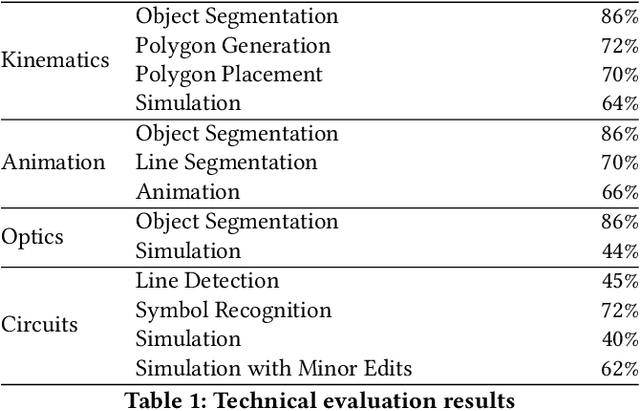



Abstract:We introduce Augmented Physics, a machine learning-powered tool designed for creating interactive physics simulations from static textbook diagrams. Leveraging computer vision techniques, such as Segment Anything and OpenCV, our web-based system enables users to semi-automatically extract diagrams from physics textbooks and then generate interactive simulations based on the extracted content. These interactive diagrams are seamlessly integrated into scanned textbook pages, facilitating interactive and personalized learning experiences across various physics concepts, including gravity, optics, circuits, and kinematics. Drawing on an elicitation study with seven physics instructors, we explore four key augmentation techniques: 1) augmented experiments, 2) animated diagrams, 3) bi-directional manipulatives, and 4) parameter visualization. We evaluate our system through technical evaluation, a usability study (N=12), and expert interviews (N=12). The study findings suggest that our system can facilitate more engaging and personalized learning experiences in physics education.
Collaboration of Teachers for Semi-supervised Object Detection
May 22, 2024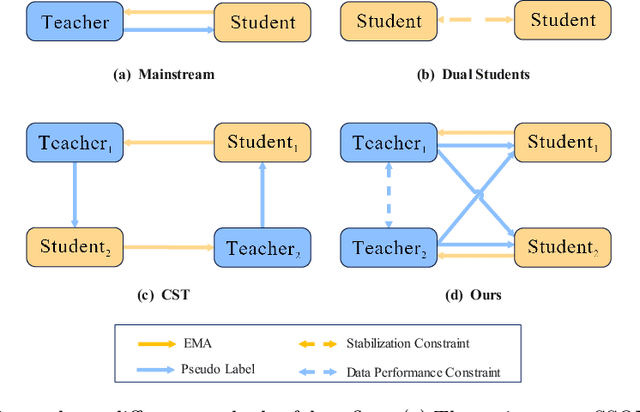
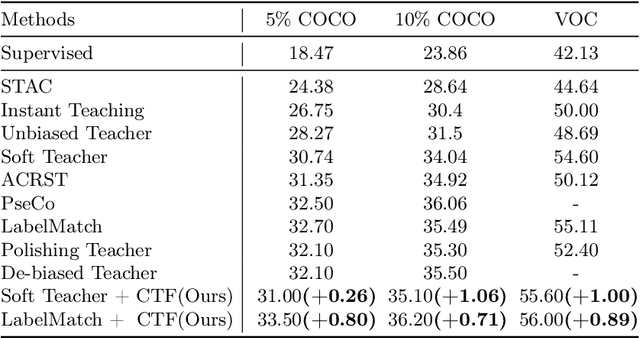
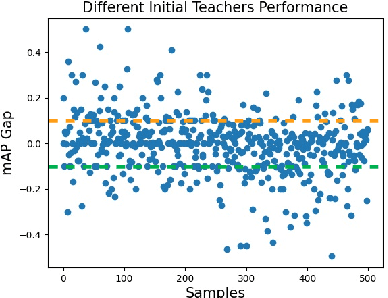

Abstract:Recent semi-supervised object detection (SSOD) has achieved remarkable progress by leveraging unlabeled data for training. Mainstream SSOD methods rely on Consistency Regularization methods and Exponential Moving Average (EMA), which form a cyclic data flow. However, the EMA updating training approach leads to weight coupling between the teacher and student models. This coupling in a cyclic data flow results in a decrease in the utilization of unlabeled data information and the confirmation bias on low-quality or erroneous pseudo-labels. To address these issues, we propose the Collaboration of Teachers Framework (CTF), which consists of multiple pairs of teacher and student models for training. In the learning process of CTF, the Data Performance Consistency Optimization module (DPCO) informs the best pair of teacher models possessing the optimal pseudo-labels during the past training process, and these most reliable pseudo-labels generated by the best performing teacher would guide the other student models. As a consequence, this framework greatly improves the utilization of unlabeled data and prevents the positive feedback cycle of unreliable pseudo-labels. The CTF achieves outstanding results on numerous SSOD datasets, including a 0.71% mAP improvement on the 10% annotated COCO dataset and a 0.89% mAP improvement on the VOC dataset compared to LabelMatch and converges significantly faster. Moreover, the CTF is plug-and-play and can be integrated with other mainstream SSOD methods.
TransLandSeg: A Transfer Learning Approach for Landslide Semantic Segmentation Based on Vision Foundation Model
Mar 15, 2024



Abstract:Landslides are one of the most destructive natural disasters in the world, posing a serious threat to human life and safety. The development of foundation models has provided a new research paradigm for large-scale landslide detection. The Segment Anything Model (SAM) has garnered widespread attention in the field of image segmentation. However, our experiment found that SAM performed poorly in the task of landslide segmentation. We propose TransLandSeg, which is a transfer learning approach for landslide semantic segmentation based on a vision foundation model (VFM). TransLandSeg outperforms traditional semantic segmentation models on both the Landslide4Sense dataset and the Bijie landslide dataset. Our proposed adaptive transfer learning (ATL) architecture enables the powerful segmentation capability of SAM to be transferred to landslide detection by training only 1.3% of the number of the parameters of SAM, which greatly improves the training efficiency of the model. Finally we also conducted ablation experiments on models with different ATL structures, concluded that the deployment location and residual connection of ATL play an important role in TransLandSeg accuracy improvement.
CartoMark: a benchmark dataset for map pattern recognition and 1 map content retrieval with machine intelligence
Dec 14, 2023



Abstract:Maps are fundamental medium to visualize and represent the real word in a simple and 16 philosophical way. The emergence of the 3rd wave information has made a proportion of maps are available to be generated ubiquitously, which would significantly enrich the dimensions and perspectives to understand the characteristics of the real world. However, a majority of map dataset have never been discovered, acquired and effectively used, and the map data used in many applications might not be completely fitted for the authentic demands of these applications. This challenge is emerged due to the lack of numerous well-labelled benchmark datasets for implementing the deep learning approaches into identifying complicated map content. Thus, we develop a large-scale benchmark dataset that includes well-labelled dataset for map text annotation recognition, map scene classification, map super-resolution reconstruction, and map style transferring. Furthermore, these well-labelled datasets would facilitate the state-of-the-art machine intelligence technologies to conduct map feature detection, map pattern recognition and map content retrieval. We hope our efforts would be useful for AI-enhanced cartographical applications.
Emu: Enhancing Image Generation Models Using Photogenic Needles in a Haystack
Sep 27, 2023



Abstract:Training text-to-image models with web scale image-text pairs enables the generation of a wide range of visual concepts from text. However, these pre-trained models often face challenges when it comes to generating highly aesthetic images. This creates the need for aesthetic alignment post pre-training. In this paper, we propose quality-tuning to effectively guide a pre-trained model to exclusively generate highly visually appealing images, while maintaining generality across visual concepts. Our key insight is that supervised fine-tuning with a set of surprisingly small but extremely visually appealing images can significantly improve the generation quality. We pre-train a latent diffusion model on $1.1$ billion image-text pairs and fine-tune it with only a few thousand carefully selected high-quality images. The resulting model, Emu, achieves a win rate of $82.9\%$ compared with its pre-trained only counterpart. Compared to the state-of-the-art SDXLv1.0, Emu is preferred $68.4\%$ and $71.3\%$ of the time on visual appeal on the standard PartiPrompts and our Open User Input benchmark based on the real-world usage of text-to-image models. In addition, we show that quality-tuning is a generic approach that is also effective for other architectures, including pixel diffusion and masked generative transformer models.
DealMVC: Dual Contrastive Calibration for Multi-view Clustering
Sep 02, 2023


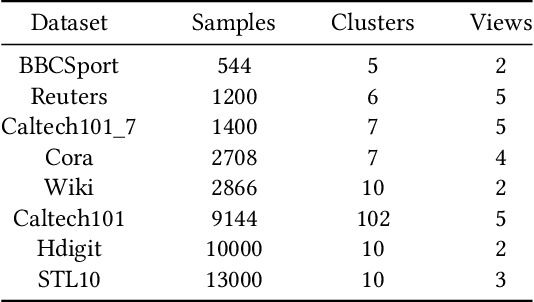
Abstract:Benefiting from the strong view-consistent information mining capacity, multi-view contrastive clustering has attracted plenty of attention in recent years. However, we observe the following drawback, which limits the clustering performance from further improvement. The existing multi-view models mainly focus on the consistency of the same samples in different views while ignoring the circumstance of similar but different samples in cross-view scenarios. To solve this problem, we propose a novel Dual contrastive calibration network for Multi-View Clustering (DealMVC). Specifically, we first design a fusion mechanism to obtain a global cross-view feature. Then, a global contrastive calibration loss is proposed by aligning the view feature similarity graph and the high-confidence pseudo-label graph. Moreover, to utilize the diversity of multi-view information, we propose a local contrastive calibration loss to constrain the consistency of pair-wise view features. The feature structure is regularized by reliable class information, thus guaranteeing similar samples have similar features in different views. During the training procedure, the interacted cross-view feature is jointly optimized at both local and global levels. In comparison with other state-of-the-art approaches, the comprehensive experimental results obtained from eight benchmark datasets provide substantial validation of the effectiveness and superiority of our algorithm. We release the code of DealMVC at https://github.com/xihongyang1999/DealMVC on GitHub.
Efficient Multi-View Graph Clustering with Local and Global Structure Preservation
Aug 31, 2023



Abstract:Anchor-based multi-view graph clustering (AMVGC) has received abundant attention owing to its high efficiency and the capability to capture complementary structural information across multiple views. Intuitively, a high-quality anchor graph plays an essential role in the success of AMVGC. However, the existing AMVGC methods only consider single-structure information, i.e., local or global structure, which provides insufficient information for the learning task. To be specific, the over-scattered global structure leads to learned anchors failing to depict the cluster partition well. In contrast, the local structure with an improper similarity measure results in potentially inaccurate anchor assignment, ultimately leading to sub-optimal clustering performance. To tackle the issue, we propose a novel anchor-based multi-view graph clustering framework termed Efficient Multi-View Graph Clustering with Local and Global Structure Preservation (EMVGC-LG). Specifically, a unified framework with a theoretical guarantee is designed to capture local and global information. Besides, EMVGC-LG jointly optimizes anchor construction and graph learning to enhance the clustering quality. In addition, EMVGC-LG inherits the linear complexity of existing AMVGC methods respecting the sample number, which is time-economical and scales well with the data size. Extensive experiments demonstrate the effectiveness and efficiency of our proposed method.
 Add to Chrome
Add to Chrome Add to Firefox
Add to Firefox Add to Edge
Add to Edge